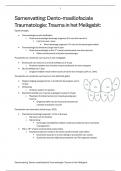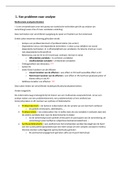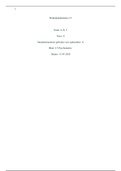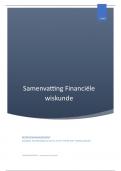10. Urbanisation in Africa (J. De Weerdt)
1. Basic facts on urbanization in Africa (from Africapolis)
The definitions of urban in Africa
- Every region has another definition of how countries define urban areas in Africa
- Egypt & Niger: The government says which are urban areas and which are not.
- Botswana & Liberia: They use population (> 2000/5000 people is an urban area & in Botswana: >75%
of the eco activity is non-agricultural)
- Comoros: look at activities
- If we look at urbanization across countries and compare these, this is not a great starting point! We
need a harmonized definition.
Some data – Africapolis: They made 1 urbanization definition:
- OECD/SWAC (2020), Africa's Urbanization Dynamics 2020: Africapolis, Mapping a New Urban
Geography.
- Data sources: they look at satellite and aerial imagery & at official demographic data such as censuses
and other cartographic sources.
- One homogeneous spatial definition of urbanization:
Physical: a continuously built-up area (200m)
Demographic: more than 10 000 inhabitants
So they look at satellite images and say that it is an urbanized area if the distance between
the houses is less than 200m. They look also at demographic data and see where there are
more than 10 000 inhabitants! This is a good starting point to start thinking about urbanization
across countries!
,Examples of what Africapolis does:
Maputo and Matola (Mozambique): Two municipalities, one agglomeration:
- Dark area: built-up area that is identified as places where there are houses close to each other
- Middle light area: another built-up area. Very soon, Maputo is going to swallow up these areas.
- It already has swallowed up Matola, which used to be a lighter area. So Mozambique only says that
Maputo is an urbanized area, but Africapolis say that it is the whole dark area!
Kinshasa: The city-region, the communes and the agglomeration in 2015:
- The opposite is happening: the dashed dotted line is the administrative DRC Kinshasa urbanized area.
- But for Africapolis: the built-up area is only the dark area. So Kinshasa is way smaller!
- So we let go of the administrative urbanization areas
, What data we have in 2015 in Africa (build-up areas with more than 10 000 people):
- 7,617 urban agglomerations
- Hosting 567m people
- 50.4% of people in Africa lived in such an agglomeration
Distribution of agglomerations in Africa, 2015:
Level of urbanization in Africa, 2015:
- Highest urbanization in North Africa: Egypt (93%) & Libya (81%)
- Lowest urbanization: Niger (17%), Burundi (21%), Eritrea (24%), Lesotho (26%) & South Sudan (27%)
1. Basic facts on urbanization in Africa (from Africapolis)
The definitions of urban in Africa
- Every region has another definition of how countries define urban areas in Africa
- Egypt & Niger: The government says which are urban areas and which are not.
- Botswana & Liberia: They use population (> 2000/5000 people is an urban area & in Botswana: >75%
of the eco activity is non-agricultural)
- Comoros: look at activities
- If we look at urbanization across countries and compare these, this is not a great starting point! We
need a harmonized definition.
Some data – Africapolis: They made 1 urbanization definition:
- OECD/SWAC (2020), Africa's Urbanization Dynamics 2020: Africapolis, Mapping a New Urban
Geography.
- Data sources: they look at satellite and aerial imagery & at official demographic data such as censuses
and other cartographic sources.
- One homogeneous spatial definition of urbanization:
Physical: a continuously built-up area (200m)
Demographic: more than 10 000 inhabitants
So they look at satellite images and say that it is an urbanized area if the distance between
the houses is less than 200m. They look also at demographic data and see where there are
more than 10 000 inhabitants! This is a good starting point to start thinking about urbanization
across countries!
,Examples of what Africapolis does:
Maputo and Matola (Mozambique): Two municipalities, one agglomeration:
- Dark area: built-up area that is identified as places where there are houses close to each other
- Middle light area: another built-up area. Very soon, Maputo is going to swallow up these areas.
- It already has swallowed up Matola, which used to be a lighter area. So Mozambique only says that
Maputo is an urbanized area, but Africapolis say that it is the whole dark area!
Kinshasa: The city-region, the communes and the agglomeration in 2015:
- The opposite is happening: the dashed dotted line is the administrative DRC Kinshasa urbanized area.
- But for Africapolis: the built-up area is only the dark area. So Kinshasa is way smaller!
- So we let go of the administrative urbanization areas
, What data we have in 2015 in Africa (build-up areas with more than 10 000 people):
- 7,617 urban agglomerations
- Hosting 567m people
- 50.4% of people in Africa lived in such an agglomeration
Distribution of agglomerations in Africa, 2015:
Level of urbanization in Africa, 2015:
- Highest urbanization in North Africa: Egypt (93%) & Libya (81%)
- Lowest urbanization: Niger (17%), Burundi (21%), Eritrea (24%), Lesotho (26%) & South Sudan (27%)











